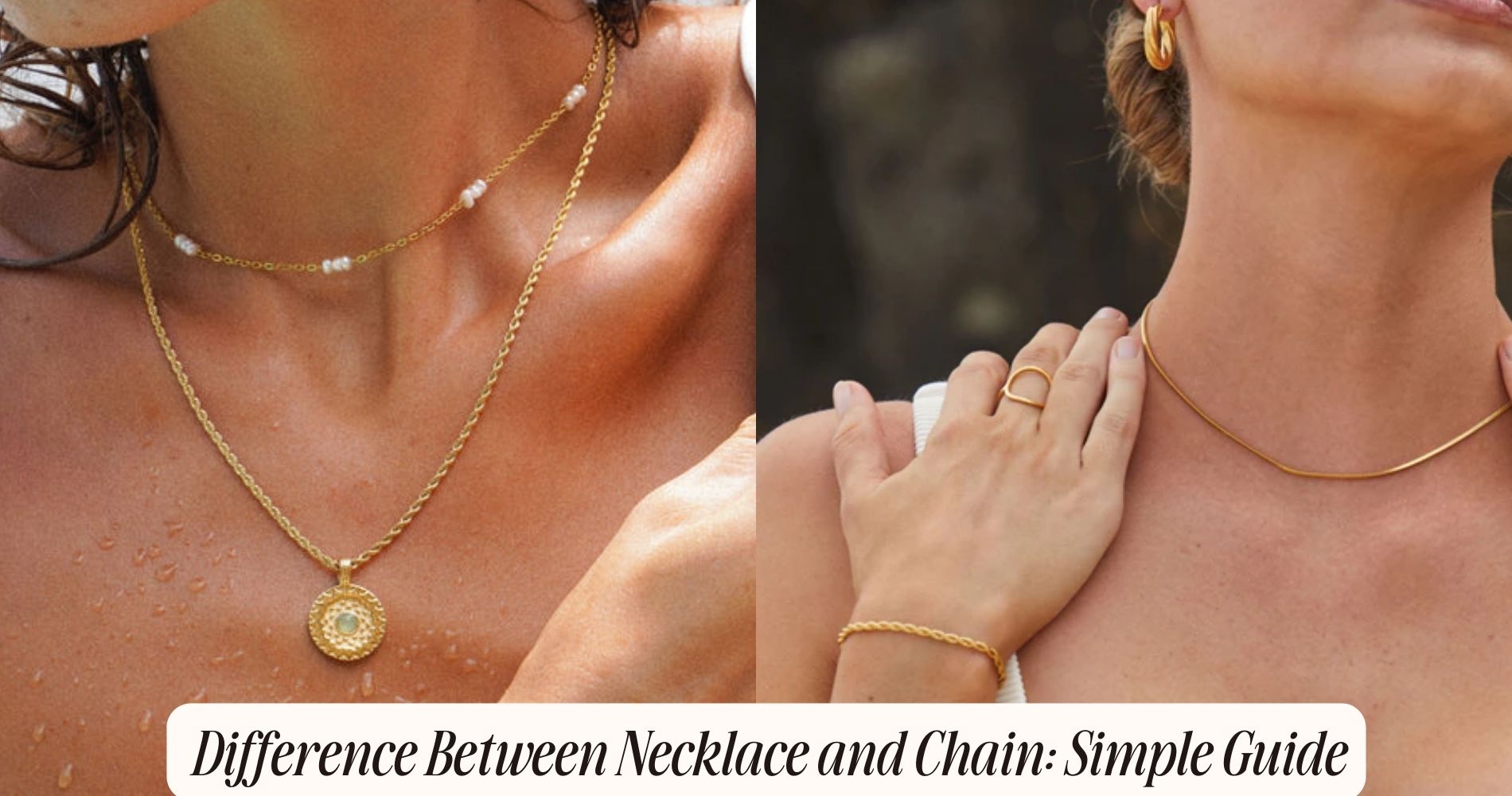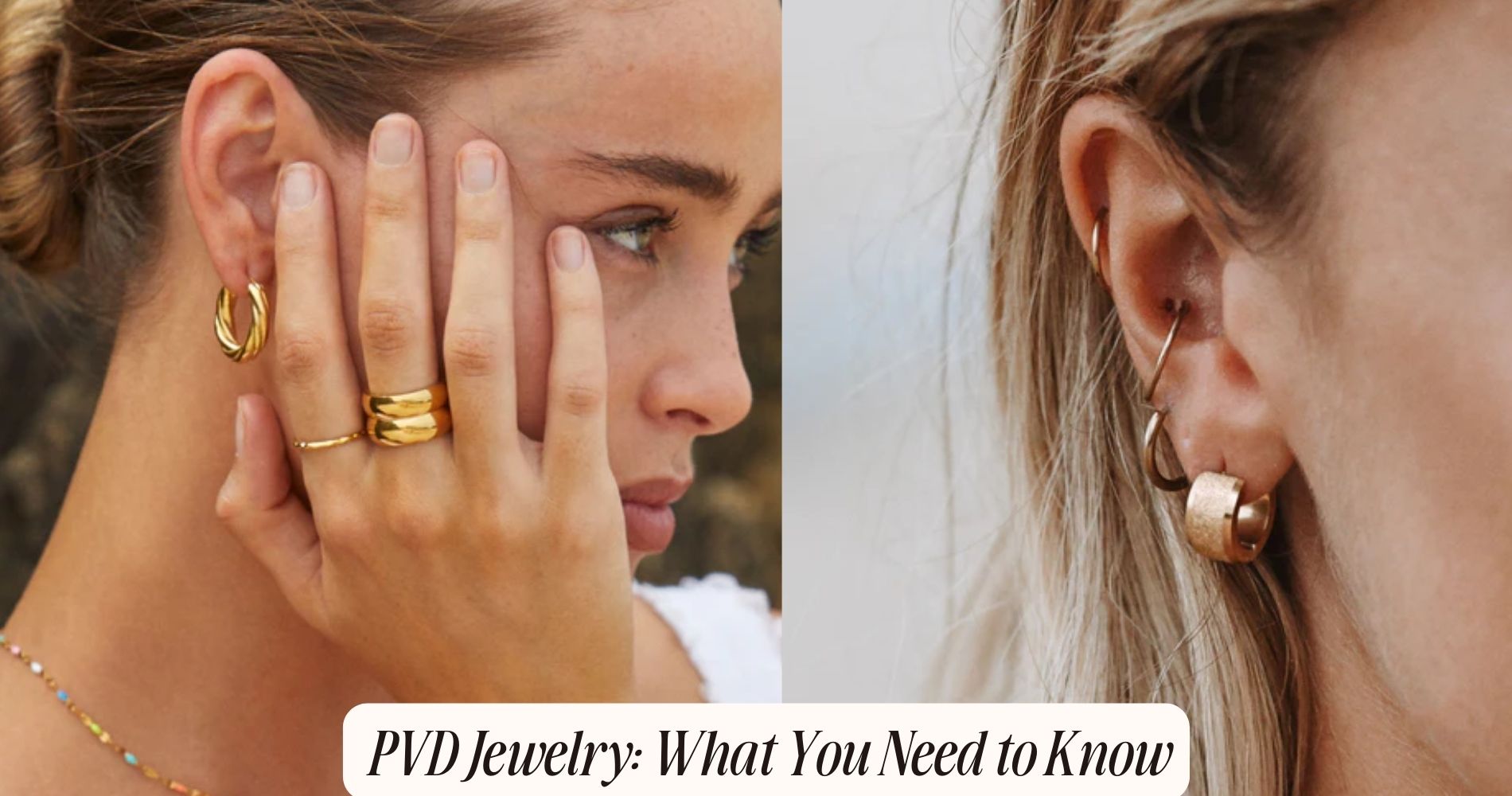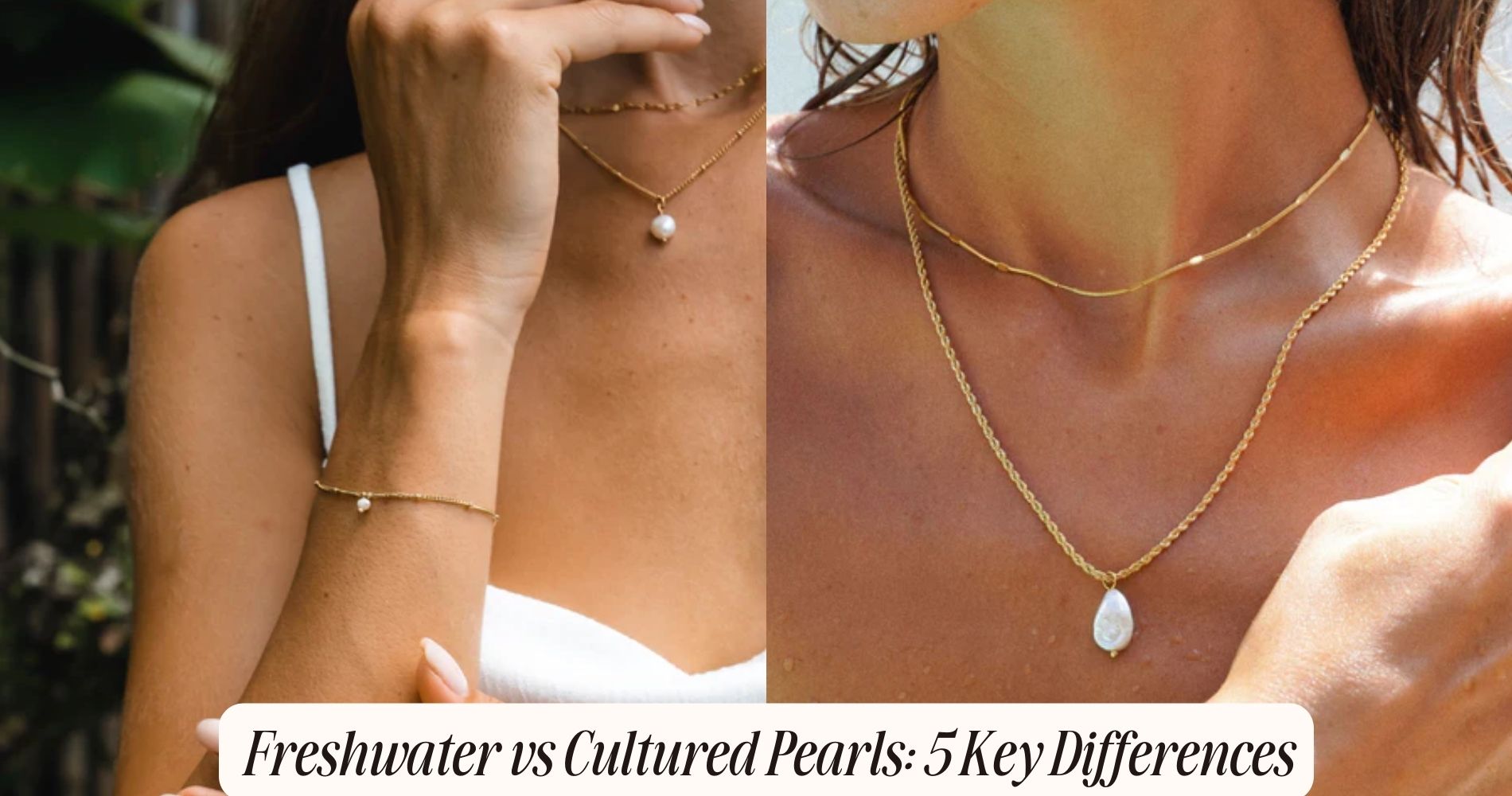
Difference Between Necklace and Chain: Simple Guide
Definition
When it comes to understanding the difference between a necklace and a chain, you first need to grasp their distinct definitions. A necklace is typically a decorative adornment worn around the neck, often featuring intricate designs and embellishments such as pendants, gemstones, or beads. Its historical origins trace back to ancient civilizations like the Egyptians and Greeks, where necklaces held cultural significance, denoting status, wealth, or religious affiliation.
On the other hand, a chain is a series of interconnected links, usually made of metal, that can be worn around the neck or used for other purposes. Chains date back to the Bronze Age, serving both functional and decorative roles. In ancient Rome, for instance, chains were often used as symbols of power and military honor.
The cultural significance of both necklaces and chains has evolved over time. Necklaces, with their more elaborate designs, have often been associated with personal expression and fashion. Chains, while sometimes plain, can also carry deep meaning, such as the Cuban link chain in hip-hop culture, symbolizing strength and success.
Understanding these definitions helps you appreciate not just their aesthetic differences but also their rich, historical contexts.
Design Elements
Diving into the design elements, you'll discover that necklaces often feature elaborate motifs, intricate patterns, and various adornments like pendants, gemstones, and beads, each adding layers of complexity and historical connotation.
Historically, these decorative patterns have been influenced by cultural symbols and artistic movements, from the intricate filigree of the Victorian era to the bold geometric designs of Art Deco.
When it comes to clasp types, necklaces offer a variety to suit both functionality and aesthetic appeal. You might encounter lobster clasps, known for their secure hold, or spring ring clasps, which are more common in delicate, lightweight pieces. Box clasps and toggle clasps can add an extra layer of elegance and sophistication.
In contrast, chains tend to focus on the simplicity and repetition of links, often foregoing the additional decorative elements found in necklaces. The patterns in chains, known as link styles, include familiar types like cable, curb, and figaro.
Each link style offers a different visual texture and strength, allowing you to choose based on both design and durability.
Materials Used
Understanding the materials used in both necklaces and chains is pivotal to appreciating their overall design and functionality. Historically, these adornments have been crafted from precious metals like gold, silver, and platinum, which not only add aesthetic value but also durability. Gold, available in various karats, offers a rich, warm hue, while silver provides a sleek, modern look. Platinum, though more expensive, is renowned for its strength and hypoallergenic qualities, making it a preferred choice for those with sensitive skin.
In addition to precious metals, contemporary designs often incorporate synthetic materials such as stainless steel, titanium, and even plastics. Stainless steel is celebrated for its corrosion resistance, making it an excellent choice for everyday wear. Titanium, lighter than most metals, provides a modern, industrial feel and is also hypoallergenic. Plastics and other synthetic materials, while less traditional, allow for innovative designs and vibrant colors, expanding the range of stylistic possibilities.
Each material used in necklaces and chains brings unique attributes, influencing not just the visual appeal but also the wearability and maintenance of these pieces. By understanding these materials, you can make more informed choices that align with your style and practical needs.
Length and Size
When considering length and size, you'll notice necklaces often come in standard lengths like princess or opera, tailored for specific styles. Chains, however, exhibit a more utilitarian range, frequently measured in millimeters of thickness and grams of weight.
Historically, these measurements have dictated not only the aesthetic but also the functional use of these adornments, with thicker chains often symbolizing strength and durability.
Standard Length Options
Standard length options for necklaces and chains typically range from 14 to 36 inches, each serving distinct style and functional purposes in jewelry design. The 14-inch choker sits snugly around your neck, often used for its youthful and trendy appeal. Historically, chokers held cultural significance, especially in ancient civilizations like Egypt, where they symbolized power and protection.
An 18-inch or 'princess' length, falling just below the collarbone, is the most popular choice for its versatility. It's perfect for pendants and carries a rich historical evolution, being favored by royalty and nobility throughout centuries.
The 20-inch matinee length, sitting at the top of the bust, offers a semi-formal look that bridges casual and elegant styles. Longer lengths, such as the 24-inch opera and the 36-inch rope, provide dramatic flair and flexibility. During the Victorian era, these lengths were particularly fashionable, often worn doubled for a layered effect. They continue to hold cultural significance in modern fashion, symbolizing sophistication and luxury.
Understanding these standard lengths helps you select the perfect necklace or chain to complement your wardrobe and express your personal style.
Thickness and Weight
In jewelry design, the thickness and weight of necklaces and chains play an important role in determining their aesthetic appeal and practical wearability. When selecting a chain or necklace, you'll often encounter the term 'chain gauge,' which refers to the thickness of the chain. A higher gauge number indicates a thinner chain, while a lower gauge number signifies a thicker one. This measurement is essential for both the visual impact and the durability of the piece.
Weight distribution also greatly affects how a necklace or chain sits around your neck. Evenly distributed weight ensures comfort and prevents the chain from twisting or kinking. Historically, thicker chains have been favored for their robustness and ability to hold larger, heavier pendants. Conversely, thinner chains, often more delicate, have been popular for their understated elegance and flexibility in layering with other pieces.
Understanding these elements helps you choose the right piece for your needs. A heavier, thicker chain might be ideal for a bold, statement look, while a lighter, thinner chain could be perfect for everyday wear or intricate layering. Balancing chain gauge and weight distribution will guarantee your jewelry not only looks good but also feels comfortable and lasts longer.
Style Variations
You'll notice that necklaces often include pendants, which add a focal point and can range from simple charms to intricate gemstones.
Chains, on the other hand, usually emphasize the material and link design without added embellishments.
Historically, the choice of materials—be it gold, silver, or platinum—has played a significant role in their distinct aesthetic and cultural significance.
Pendant Vs. No Pendant
Have you ever wondered how the presence or absence of a pendant can dramatically alter the aesthetic and historical significance of a necklace or a chain? When you add a pendant, you're not just accessorizing; you're making a statement. Pendant types vary widely, from the classic solitaire diamond to intricate lockets and symbolic charms. Each type brings its own historical context—lockets, for example, have roots in the Victorian era, often used to hold keepsakes or photos.
Without a pendant, chains gain their own popularity due to their simplicity and versatility. Chains like the Cuban link, rope, and Figaro stand strong on their own, showcasing the craftsmanship of the links. Historically, chains without pendants have been favored for their understated elegance, allowing the wearer's personality to shine through without additional adornments.
Material and Design Choices
When choosing between a necklace with a pendant and a simple chain, the materials and design choices you make play a pivotal role in defining the piece's overall style and functionality. Opting for precious metals like gold, silver, or platinum guarantees durability and adds a touch of elegance. Each metal's unique properties contribute to its aesthetic and longevity. For example, platinum's resistance to tarnish makes it ideal for heirloom pieces, while gold's malleability allows for intricate designs.
Consider craftsmanship quality when selecting your piece. High-quality chains exhibit uniformity in their links and a smooth finish, while necklaces with pendants often showcase detailed artistry. Custom engravings can add a personal touch, transforming a simple chain into a meaningful keepsake. Historically, engraved jewelry dates back to ancient civilizations, where it was used to signify social status or convey messages.
Design variations also influence your choice. A simple chain can range from delicate and dainty to bold and chunky, each style offering a different look. Meanwhile, a necklace with a pendant provides a focal point, drawing attention to a specific design, gemstone, or emblem. Understanding these nuances enables you to select a piece that aligns with your personal style and functional needs.
Common Uses
Necklaces are often used as statement pieces in fashion, serving both decorative and symbolic purposes, while chains typically offer more versatile, minimalist applications.
On gift occasions, necklaces make memorable presents, often chosen for their intricate designs and gemstones. They carry cultural significance, symbolizing milestones like anniversaries or rites of passage. For instance, in many cultures, a necklace might be gifted during a wedding ceremony to signify eternal love.
Chains, on the other hand, are frequently appreciated for their simplicity and adaptability. They serve as everyday accessories that can be dressed up or down, making them ideal for various settings. Historically, chains have been used across different cultures as symbols of power and wealth. In ancient Rome, gold chains were worn by the elite to display their status.
When considering the technical terminology, a necklace typically includes elements like pendants, beads, or intricate metalwork, whereas a chain is generally a series of connected links, often devoid of additional adornments.
You'll find that chains are easier to layer with other jewelry, offering a minimalist canvas that complements rather than competes with other pieces.
Understanding their common uses helps you better appreciate when and how to wear each type of jewelry.
Choosing the Right Piece
Understanding their common uses helps you better appreciate when and how to wear each type of jewelry, guiding you to choose the right piece that complements your outfit and expresses your personal style. Chains, often simpler and more versatile, are perfect for everyday wear. They can be worn solo for a minimalist look or adorned with pendants to add a touch of elegance.
Historically, chains have been favored for their sleek design and adaptability, tracing back to ancient civilizations where they symbolized status and wealth.
On the other hand, necklaces, often more elaborate, are ideal for special occasions. They commonly feature intricate designs and gemstones, making them statement pieces. When selecting a necklace, consider the neckline of your attire and the event's formality. For instance, a choker pairs well with a strapless dress, while a pendant necklace complements a V-neck.
Ultimately, your personal preference plays an important role. Consider what resonates with your style and the message you wish to convey. Whether it's a simple chain for a casual day out or an ornate necklace for a wedding, choosing the right piece can elevate your look and leave a lasting impression.
Frequently Asked Questions
How Do You Care for Necklaces and Chains?
To care for necklaces and chains, use specific cleaning techniques like ultrasonic cleaners and soft brushes. Preventing tarnish involves storing them in anti-tarnish pouches and avoiding exposure to chemicals. Regular maintenance keeps them pristine.
Can Necklaces and Chains Be Worn Together?
You can absolutely wear necklaces and chains together. Embrace layering techniques to stay on top of fashion trends. Historically, combining different lengths and textures adds depth, showcasing your style's richness and variety.
What Is the History of Necklaces and Chains?
You'd find that necklaces and chains have a rich history. Ancient civilizations crafted them with symbolic meanings, often using precious metals and gemstones. These pieces were more than adornments; they represented status, power, and spirituality.
Are There Cultural Significances for Necklaces and Chains?
Yes, necklaces and chains hold cultural significances with traditional meanings and symbolic representations. For instance, in many cultures, they signify status, spirituality, and rites of passage, reflecting historical contexts and deep-rooted societal values.
How Do You Properly Store Necklaces and Chains?
To properly store necklaces and chains, you should use jewelry boxes equipped with anti-tarnish strips. These strips prevent oxidation, preserving your pieces. Make sure each item is separated to avoid tangling and scratching, maintaining their pristine condition.
Conclusion
Essentially, grasping the distinction between a necklace and a chain enhances your jewelry knowledge.
While necklaces often feature pendants and intricate designs, chains are more straightforward, emphasizing the craftsmanship of the links.
Historically, materials like gold and silver symbolize status and longevity.
Length and style variations cater to various trends, ensuring you select the perfect piece for any event.
Delve deeper into these specifics, and you'll confidently choose jewelry that complements your individual style and background.
























Leave a comment
This site is protected by hCaptcha and the hCaptcha Privacy Policy and Terms of Service apply.